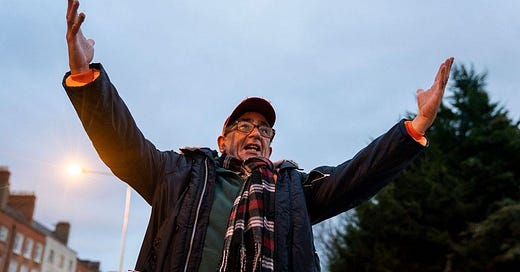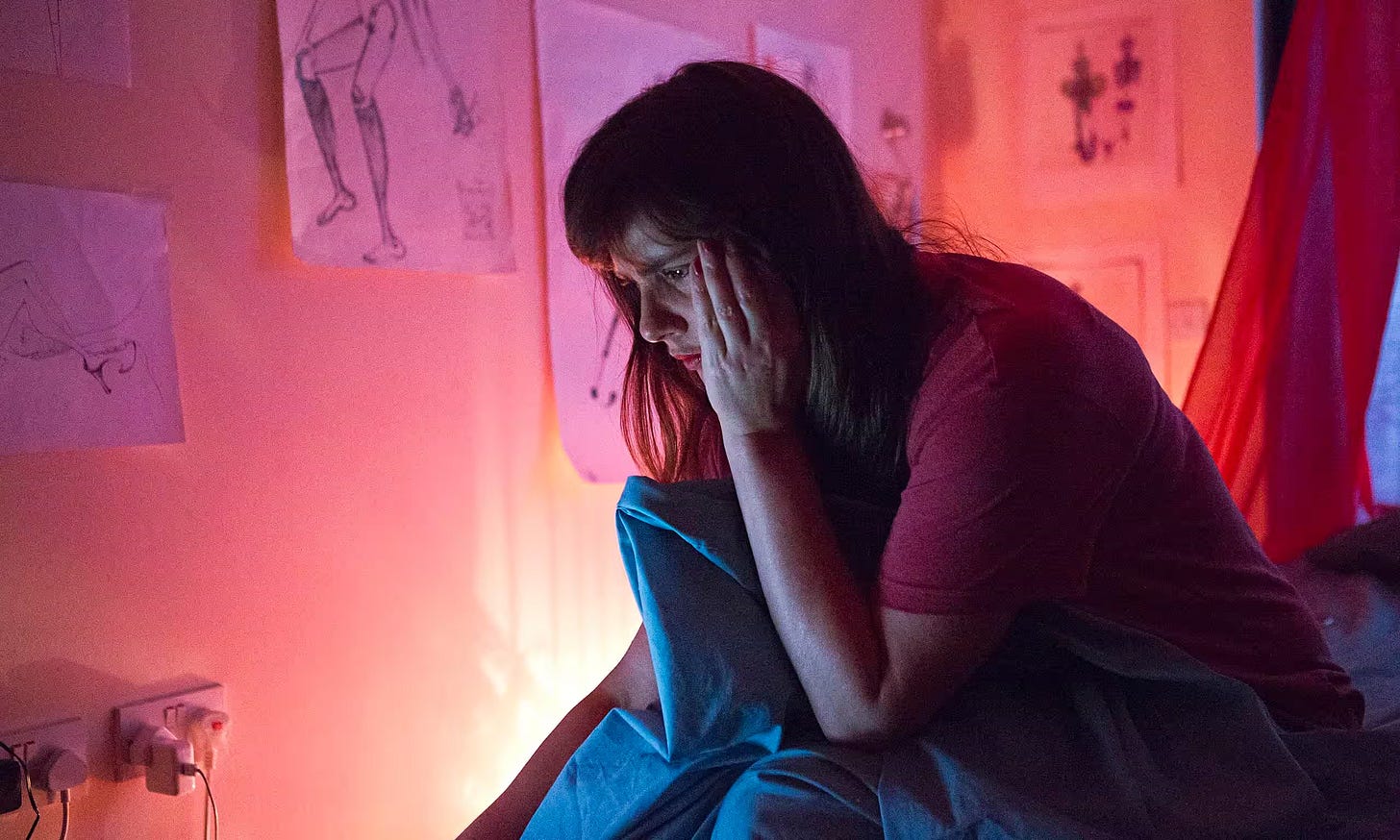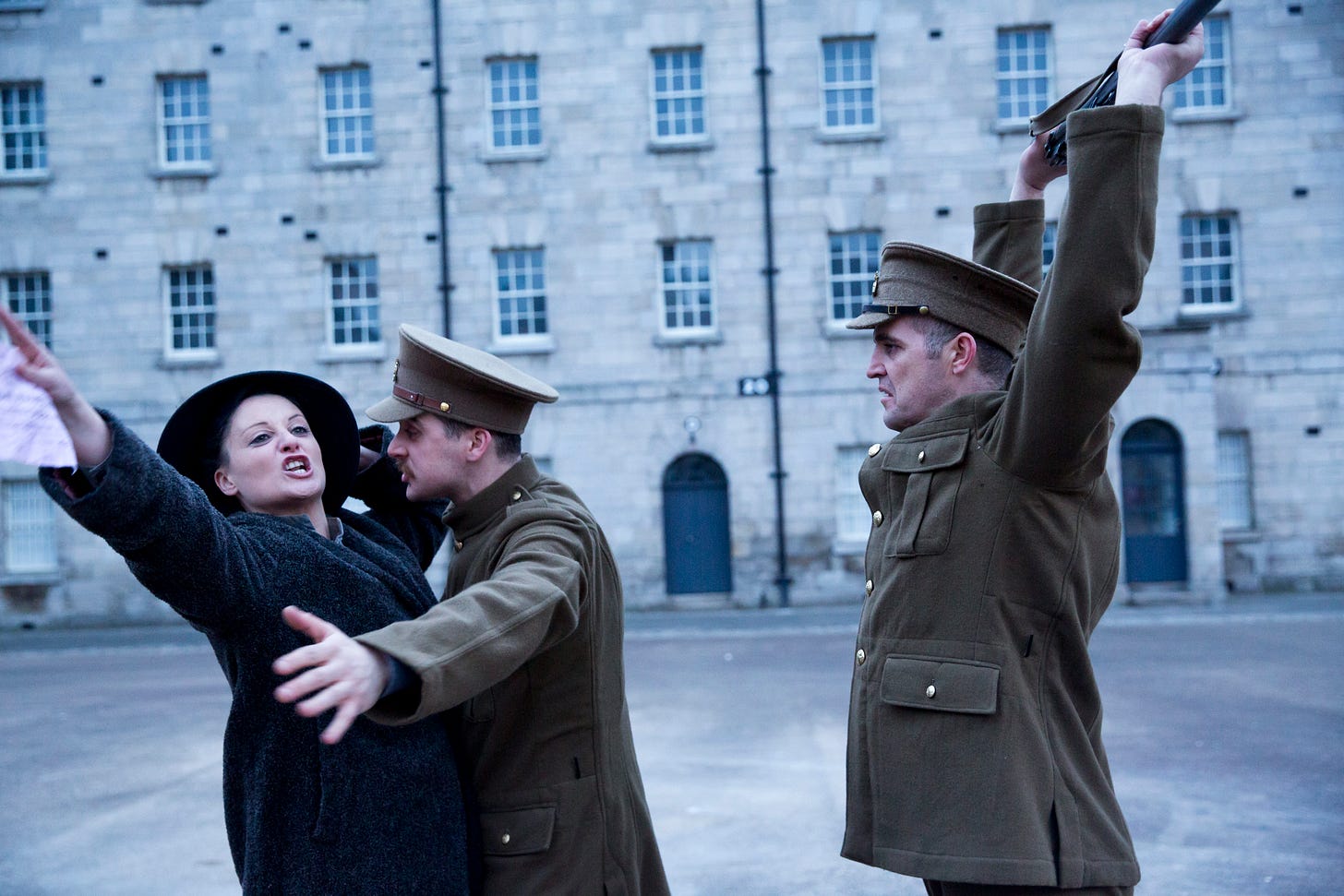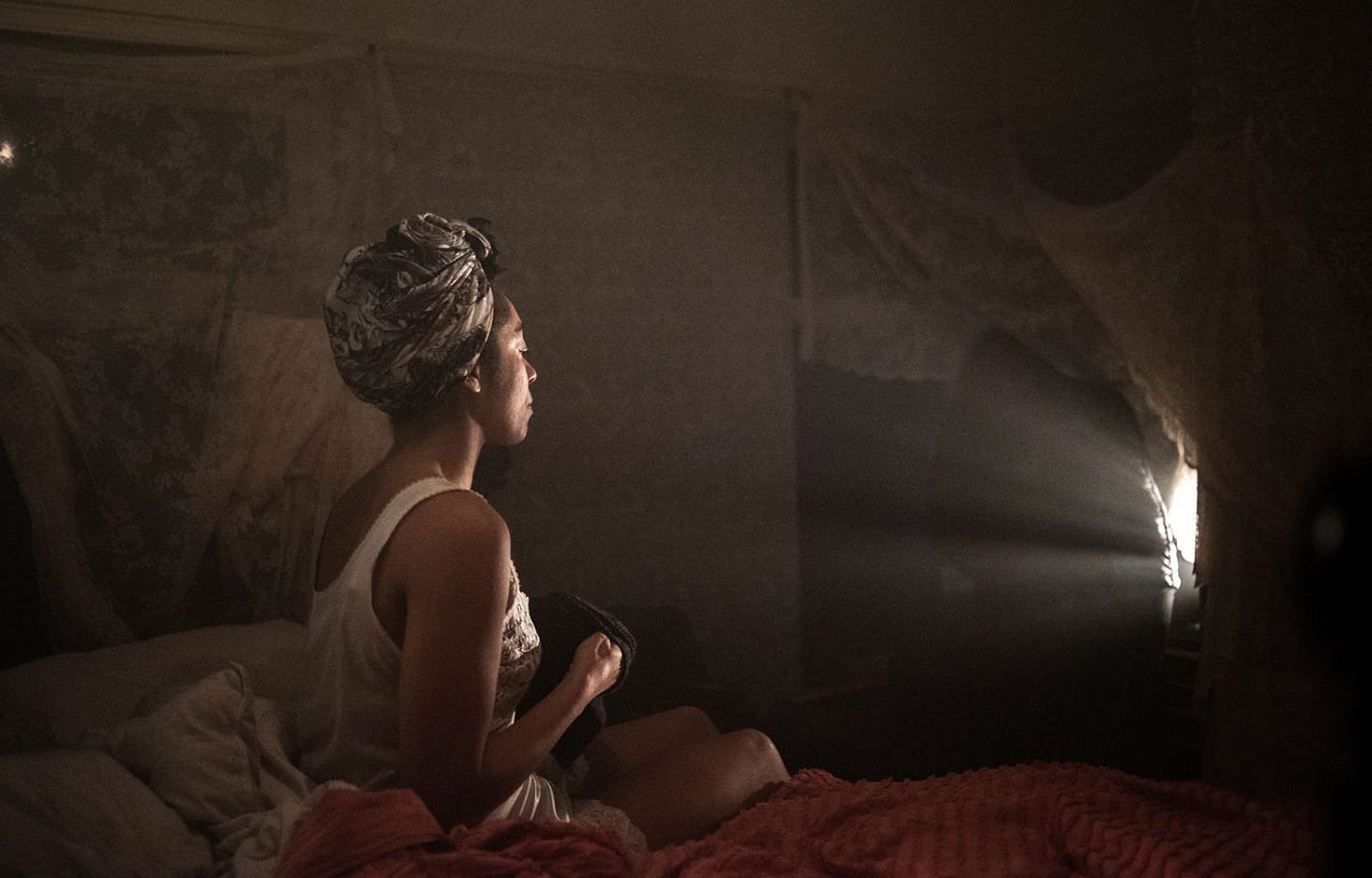Living history: ANU, the Irish company connecting the past with the present
On an Irish company making immersive work that brings the past to life.
This week’s Café Europa is devoted to ANU Productions, the renowned Irish company whose work I’ve been fascinated with ever since I saw - experienced is probably the better word - their 2018 show The Lost O’Casey as part of the Dublin Theatre Festival (here’s my review in The Stage). So, I was obviously delighted to have the opportunity to talk to Louise Lowe, the company’s co-director and a real force in Irish theatre, about their work and the ways in which it engages with history, place and memory.
Café Europa is free to read and I would love to keep it that way, but it also takes a lot of time to research and write. If you’d like to help keep it going you can do that in a number of ways, by subscribing if you don’t already do so, or by becoming a paid supporter. Or just by sharing it with others who might appreciate it. That helps too.
An old man shambled up to me on a Dublin street corner and started to talk. If you want to know the story of a city, he told me, you’ll find it in the surrounding streets, not tucked away in some museum.
This was the beginning of Irish company ANU’s production of The Lost O’Casey, a performance based on a lost play by Sean O’Casey, Nannie’s Night Out, which explored the life of a meths-drinking young woman from the tenements. It was performed at the Abbey Theatre only once, in 1924. ANU used this text as the basis of a performance which, like a lot of their work, is designed to be experienced by just four people at a time. The talkative old man was like the White Rabbit, kicking off a journey into the hidden bits of the city. Our little group of four was soon split up, tugged in different directions, and I found myself trailing a group of rowdy lads into a run-down block of flats. The flats were due to be demolished, swept away in the name of urban redevelopment, and the lads were all facing eviction - and all set on getting off their faces.
I was plopped down on a sofa as the lads pinged about the flat. Amid the banter there were snatches of chat about one of their mates, a gifted young boxer who died by suicide. The whole experience was disorientating, thrilling, and genuinely immersive in a way a lot of immersive theatre isn’t. It was like tumbling into another world.
The performances switched nimbly between this kind of intensely intimate naturalism and more stylised movement sequences, woozy slow-motion dancing. Later I found myself upstairs in one of the lad’s rooms, and the show pulled off a moment of close-quarters magic. For the briefest of moments, it was like seeing a ghost - I still remember the way it made my heart flutter.
During the performance we were taken to other spaces, to a mobile medical unit, where a young GP talked about the her own housing precarity as we finally encountered the chaotic and volatile Nannie. The genius of the piece was both the deft way it wove exploration of mental illness, addiction, and the lack of social safety nets, into its theatrical fabric and the way it used the city, as a canvas, as a stage, taking you into places you’d probably not otherwise find yourself. I remember feeling elated and dazed at the end, looking at both the surrounding buildings and the passing people differently. Was the show even over?
“I love making history feel vital” - an interview with Louise Lowe
Founded in 2009, and co-directed by Louise Lowe and visual artist Owen Boss, ANU is an interdisciplinary company whose work often blurs the line between theatre, dance and installation. They’re one of the most well-regarded companies in Irish theatre, and arguably one of the most prolific.
Their next project, Starjazzer, which is also based on a story by O’Casey, forms part of this year’s Dublin Theatre Festival. The text was suggested to them by O’Casey’s daughter Shivaun. The story, which O’Casey himself described as more of a dance than a story, was inspired by his upstairs neighbour. He describes watching her hanging out the laundry alone in the courtyard before starting to dance, privately, in communion with the night sky. “She has this amazing kind of epiphany, I suppose, about her body and herself, and this celestial moment of imagining – a complete emancipation from the ordinary domestic life,” explains Lowe.
O’Casey’s story describes the dance in detail – it borders on a written form of choreography, says Lowe – it also describes the marital rape that happens when she returns to her home, which she thinks was the reason the story was banned. “Not because marital rape was illegal. It wasn't actually made illegal in Ireland until 1996, but it was because she said ‘no’. It was the idea that a woman could refuse her husband.”
While the material is rich, the story itself is short so Lowe has paired it with a second contemporary narrative, “two singular stories that meet in the middle, and they talk to each other across 100 years without seeing each other.”
There are very few traditional tenement houses left in Dublin, so Starjazzer will be performed at Dublin’s Royal Society of Antiquaries. Lowe was initially resistant to this. “It’s too fancy to be a tenement,” she says, but it also houses the Darkest Dublin Collection, which includes a series of lantern slides. These images of pre-1913 Dublin are some of the only photographs of tenement rooms of this time. The images are on glass plates, and the way they captured the light of the moment in which they were taken inspired Lowe and her co-creators. The sound designer and composer used a programme, to “extracted the music from the data of the light” which form the basis of the score to which the choreography is performed. The building may be a handsomely restored Georgian structure now, but this is a way of transporting the audience into its past.
Light from a lost city
This quality is present in much of ANU’s work. Lowe and her collaborators have developed methods of making the membrane that divides then from now feel thinner. The companies work can be divided into cycles. The Monto Cycle, a series of four durational performances, made between 2010-14, documented “a quarter square-mile area in the north of the city where I grew up,” explains Lowe, and “what has and hasn’t changed for the people who live there.” The first piece, World’s End Lane, focused on the neighbourhood’s history as a red light district and once again saw small audiences – in this case, three people at a time - taken on individual journeys. This was followed by Laundry set in the Gloucester Laundry, the last Magdalene laundry to close its doors (in 1996!). Next came The Boys of Foley Street inspired by a famous 1970s radio documentary in which four young boys were interviewed about their lives. The cycle concluded Vardo which brought things up to date, exploring the lives of the city’s sex workers and other undocumented workers. “You leave more alert, inquisitive, and compassionate to hidden stories, as though encouraged to see the world anew,” wrote the Irish Times about Vardo. (Here’s a more detailed overview of the full cycle).
This kind of theatrical “excavation” needs to be done with care, Lowe says. “I don't know that I could have made it had I not been from that area,” she says. In order to go into those buildings and spaces, she says, it was important they had people’s permission, “to not just parachute in.”
“You need to build structures inside the community,” she says. ANU frequently works with community groups in order to “find a way for that community to tell its own story, and not just make it about them, but with them and for them.” With The Lost O’Casey, they conducted a months-long engagement plan with local residents groups, groups for addicts in recovery and with people who were being moved out of those blocks. They also worked with a linguistic anthropologist, as well as with a group of trainee GPs and a group of architects from Dublin City Council who were redeveloping the flats in the area (“which, may I add, still hasn't happened yet,” she says). This research was, she says, “a very long protracted process in order to understand the real complexities around language, around voices and what it was Sean was capturing, the rigor of that language, the potential loss of it, and what that meant to the city.” This kind of “slow- burn engagement” takes time to develop and often continues after the project is over. Having built those bonds, they don’t just end with the end of the project and they often maintain contact, allowing them to see the reverberations of the work in the community long after the show has run its course.
Memory plays: The Decade of Centenaries
As they were making the Monto Cycle, they were aware they were entering a “big decade of history,” a ten-year period which marked the centenaries of a number of pivotal events in Irish history. Commemoration is complicated in Ireland, she says. “We've tried to forget it all. We've actively had to because of the way the Civil War split and divided the country.” Awareness of this didn’t dull their ambition, if anything the opposite is true. The Decade of Centenaries cycle eventually included 22 productions focussed on recreating and interrogating this revolutionary period of Irish history, with multiple projects exploring different facets of the 1913 Dublin lockout, the 1916 rising, the War of Independence and the Anglo-Irish Treaty. Some of the work was small and intimate, but much of it was huge in ambition and scale, like 2022’s Staging the Treaty, an epic theatre production spanning four nights and featuring a cast of 45, that brought to life the Dáil Debates on the Anglo-Irish Treaty. There were installations, movement-driven pieces, exhibitions, even a bus tour, concluding with 2023’s Hammam, a co-production with the Abbey Theatre, which recreated the Hammam Hotel, one of the last Civil War hold-outs. It’s an extraordinary undertaking by any measure. “It was like my life's work in some ways,” she says. “It has been, without doubt, the most painstakingly brilliant, terrifying, exhilarating thing I've ever planned.”
Their shows from this period also focused on the First World War, like 2015’s Pals - the Irish at Gallipoli, which focused on the lives of four soldiers from the Royal Dublin Fusiliers. (You can hear Lowe discussing this here on RTÉ’s The History Show). When the National Museum came to them and asked them to make Pals as part of the 14-18 Now centenary project, Lowe was initially resistant. She didn’t think people would want to see a story “about four posh boys.” She was wrong. The show was a huge success. “It made me realize there were 215,000 Irishmen there, and yet we don't talk about them, we don't celebrate them here.” Collaborating with 14-18 Now allowed them to represent those voices and tell the stories of those young men.
They’re currently in the middle of what she calls their social cycle – “or the Greek cycle, that’d be a better word for it, right?” - which includes projects like The Lost O’Casey and 2018’s Torch, which told the stories of several different generations of women in the Merseyside town of St Helens. The Stage’s review of Torch, said – correctly, I think – that “it is difficult to make such one-on-one interactions feel truthful, but the company has perfected this.” Lowe’s work, more than most work I’ve seen, succeeds in making the audience feel enmeshed in the world of the production.
What sparked her interest in this mode of making work? Lowe remembers watching this performance by the artist Amanda Coogan. “I realized after a while that I was quite intoxicated with what she was doing. After about two hours, I realized I was trying to make my breathing in sync with hers, because for the first time, me being there mattered.”
It felt to her that “in that moment, we're in this together. She's feeding off my energy and I off hers.” She began to wonder if was possible to create the same sensation in theatre, the sense that “being there as an audience member really mattered, that you weren't just there to simply be a voyeur.” What happens if, she says, “the placement of the audience inside that artwork, meant that I could create environments in which that kind of communion could happen, whereby whatever the audience member does in that moment will feed and fuel the performance.” It’s this idea, she says, “that has fuelled my work more than anything else, that moment of communion or engagement with between audience and performer.”
The sites and locations in which their shows are performed inevitably also feed into the work. Take Pals, for example. The National Museum is housed in what was the first purpose built barracks in Ireland, so they set out to recreate that. “We rebuilt them, remade their beds, remade the structures that they would have looked at.” Their 2021 show The Book of Names was performed in the Pumphouse in Dublin Port that was once home to the IRA’s Q Company (you can hear Lowe talking more about the making of this show here). “There's a potency and a residual energy to that site that you can hold in the most brilliant way,” she says. Some spaces, like the Magdalene laundry, feel almost “holy” to Lowe. When making work there, “you hope you can make something that can speak to a whole country about our responsibility to what we now know.”
Bringing The Dead to life
Next year, the company will begin another five-year project called Framing the Nation, which will look at “the birthing of the nation and the kind of the embryonic state of what we did to ourselves in order to get to where we are now.” But before that, in November, they have an upcoming production of Joyce’s most famous short story, The Dead.
Having already collaborated with Landmark Theatre and the Museum of Irish Literature (MoLI) on Ulysses 2.2, a year-long project to mark the centenary of its publication, they were invited by the MoLI to turn their attention to The Dead. “We're going to bring this story to life in a way that pushed you to think about Ireland on the cusp of nationhood.” Ultimately she hopes, “we'll get a sense of where we might fit now in the story from a 2024 perspective.”
While she hopes the Joyce purists will still be satisfied, she also hopes that the show will “allow us to feel that we can position ourselves inside this point of time and the language and the beauty of it.” You can hear the excitement in Lowe’s voice as she tells me their costume designer is in Paris sourcing costumes for The Dead. “I'm just a frustrated historian end of day,” Lowe laughs. “I love history, and I love trying to make it feel important and vital.”
This week in European theatre
A round-up of festivals, premieres and other upcoming events over the next seven days
Resistance Now! – In the run up to the elections at the end of September in Austria, in which the FPO looks likely to do dismayingly well, Milo Rau has embarked on a global tour to spread a message of resistance to the rise of nationalist parties in Europe. Together with Luanda Casella, Milo Rau will give the opening speech at the World Congress of the International Theatre Institute ITI in Antwerp on 19th September. He will then visit the Segal Centre in New York on 23d September.
Kasimir and Karoline – Following her epic, six-hour take on Tony Kushner’s Angels in America (which I wrote about here), Slovenian director Nina Rajić Kranjac turns her attention to Austro-Hungarian playwright Ödön von Horváth’s weighty play, written just before Hitler came to power. It premieres at City Theatre Ljubljana on 19th September
Sirenos – The form-straddling Vilnius International Theatre Festival is composed of a Lithuanian theatre showcase including Yana Ross’ Consider the Lobster, inspired by the essay by David Foster Wallace among other texts, and Dilettante (*Seduced Angel) by Žilvinas Vingelis, which is described as a “one act audio-visual monospectacle” inspired by the work of Jean Cocteau, as well as small international programme including work from Belgium’s Silke Huysmans and Hannes Dereere. The festival opens on 25th September and runs until 10th October.
Thanks for reading! If you have any feedback, tips, or thoughts about this newsletter, you can reach me on natasha.tripney@gmail.com







